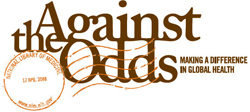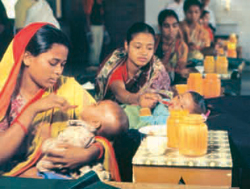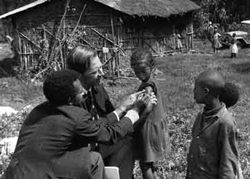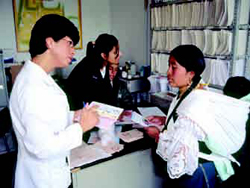 "Against the Odds," a new exhibition at the National Library of Medicine, showcases the remarkable changes that are occurring in global health and some of the pioneers who have been creating these changes.
"Against the Odds," a new exhibition at the National Library of Medicine, showcases the remarkable changes that are occurring in global health and some of the pioneers who have been creating these changes.
A revolution in global health is taking place in villages and towns around the world. Communities are collaborating with scientists, advocates, governments, and international organizations to help prevent disease and improve quality of life.
"Against the Odds: Making a Difference in Global Health" is a new exhibition at the National Library of Medicine in Bethesda, Md., that looks at this revolution and some of the milestones that have occurred along the way. Through the use of historical photos, first-person accounts, and examples of successful interventions and campaigns, the exhibition traces a remarkable story of achievement against great odds.
Components of the exhibition include community health projects from South Africa to post-Katrina New Orleans, antiobesity campaigns in Brazil, a history of the AIDS epidemic and the global response by the World Health Organization, and campaigns to ban land mines, prevent nuclear war, and end malaria, polio, and smallpox, among other topics.
Recognizing the many factors that cause illness, people are working on a wide range of issues—from community health to conflict, disease to discrimination. This exhibition will introduce you to some of individuals who have made a difference—working together, against the odds, for the benefit of all.

Photo: ICDDR,B
Oral Rehydration Therapy
Oral rehydration therapy (ORT) is an inexpensive, life-saving treatment for dehydration. Wherever access to clean water and sanitation is limited, diarrheal diseases like cholera threaten lives, especially those of babies and young children. ORT, which is essentially a mixture of salt, water, and sugar, has earned the label "a simple solution" because it is made from basic, inexpensive ingredients, and can be easily learned.

Dr. D. A. Henderson (second from left) helped lead the World Health Organization's global campaign to eradicate smallpox. The disease was eliminated in 1977 thanks to an extensive vaccination program. Photo: Ethiopia, ca. 1972, courtesy WHO
Smallpox and Polio
The successful campaign against smallpox inspired confidence that other diseases could also be eliminated. In 1985, the Pan American Health Organization (PAHO) launched a campaign to eradicate polio from the Americas. At the time, Central Americans faced major health problems due to ongoing conflict in Guatemala, El Salvador, and Nicaragua. As well as injuries caused by the violence, the warfare had a devastating impact on living conditions and health services. PAHO worked with government leaders, combatants, and local organizations to create Health as a Bridge for Peace—a plan to end hostilities and provide medical care.

Mother and child visiting a clinic in Ecuador, 2005.
Photo courtesy of PAHO/WHO
Childhood Immunization
As part of a campaign to prevent the spread of infectious diseases across Central America in the 1980s, healthcare workers promoted childhood immunization against polio, diphtheria, whooping cough, tetanus, and measles.
Visit the Exhibition Online!
" Visit the exhibition online at the National Library of Medicine website."
